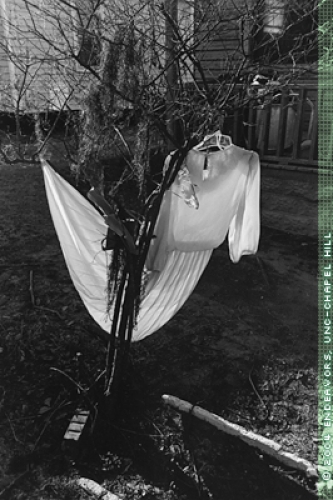Hearing the voices of their neighbors gets the people of Grifton stirred up. A tape plays of Walter Davis speaking about the flood of 1999 destroying his house and how the Baptist men’s association helped him rebuild. Betty Howes stands up, tears in her eyes, to say that in 2003, Davis passed away. “I don’t think enough attention has been paid to the impact the flood has had on the elderly,” she says.
The Eastern North Carolina town of Grifton, population 5,470, got hit hard by 1999’s Hurricane Floyd. When the waters rose, many residents had to be awakened in the middle of the night and rescued by boat. The town lost 300 homes.
A few months after the flood, researchers from Carolina’s Southern Oral History Program (SOHP) went down to Eastern North Carolina. Between December 1999 and January 2000, freelance photographer Rob Amberg and Charlie Thompson, then with SOHP and now with Duke University’s Center for Documentary Studies, traveled and talked to people. A year and half after the flood, SOHP doctoral candidate Katie Otis and freelance writer Leda Hartman visited again, interviewing flood survivors, volunteers, and government officials in Grifton as well as Rocky Mount, Greenville, Wallace, Princeville, and White Stocking.
In October 2003, at two o’clock on a Saturday afternoon, the historians have come to share the interviews with the people who talked to them. They show slides, they play tapes. And then they listen again.
In Thompson’s audio presentations he describes the “flurry of aid” sent to Grifton and the rest of Eastern North Carolina. Volunteers arrived from all over the country to clean, make meals. But, Thompson found out, some aid was “ill advised or badly carried out.” “Listening to the people takes time,” he says. “But it is a crucial step.” We can’t assume, he says, that the government already knows what the people need.
Barbara Whitehead, a Grifton resident who managed one of the shelters for flood victims, agrees. She stands up to say that state and federal aid should be better coordinated with local officials. Many people had no transportation to travel to Greenville to fill out FEMA forms, but it took some persuading to get FEMA workers to come to them. And when federal and state workers did come, some were rude about not understanding the down-East dialect.
Otis and Hartman, at the front of the room with a large flip chart, write it all down.
The town has done some recovering. The tax base before the flood was $52 million, says Grifton Mayor Timothy Bright. In 2003, it has improved, to $63 million. “So we have established a pattern for some growth,” Bright says.
And one good thing that came from the flood, he says, was that people in town reached out to each other. “Disaster didn’t know color or socioeconomic station,” he says. “Everybody got dirty, and I’m proud of that.” Betty Howes started an outreach mental-health clinic as a result of the flood. Before she started that work, she had never even driven down Water Street, in a lower-income neighborhood. Howes says, “Now I go a lot of places I didn’t used to.”
Danny DeVries, doctoral student in anthropology, also presented his work in Grifton. Tapes, transcripts, and photos from “Voices Over the Water: Oral Histories and Photographs from North Carolina’s Great Flood,” will be stored in the Southern Historical Collection in Carolina’s Wilson Library.


